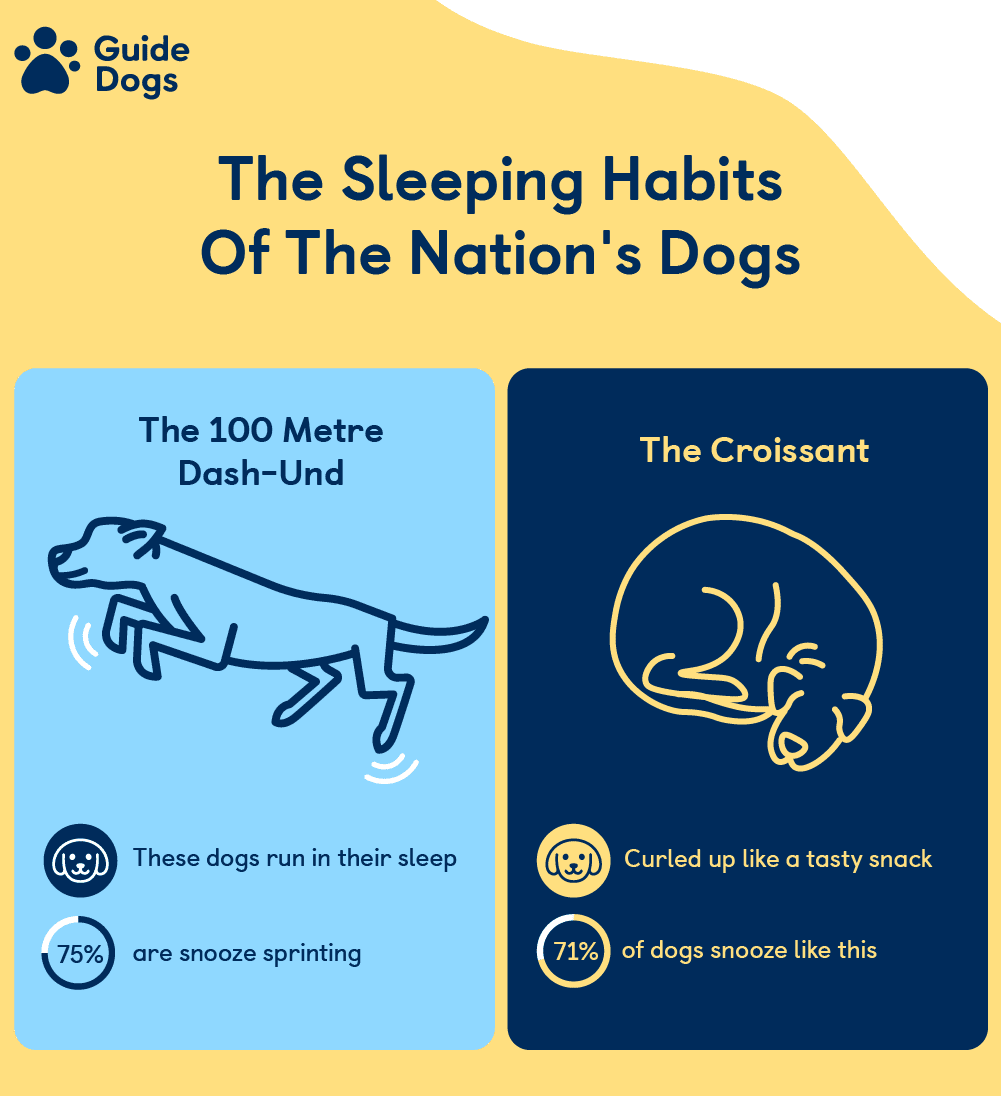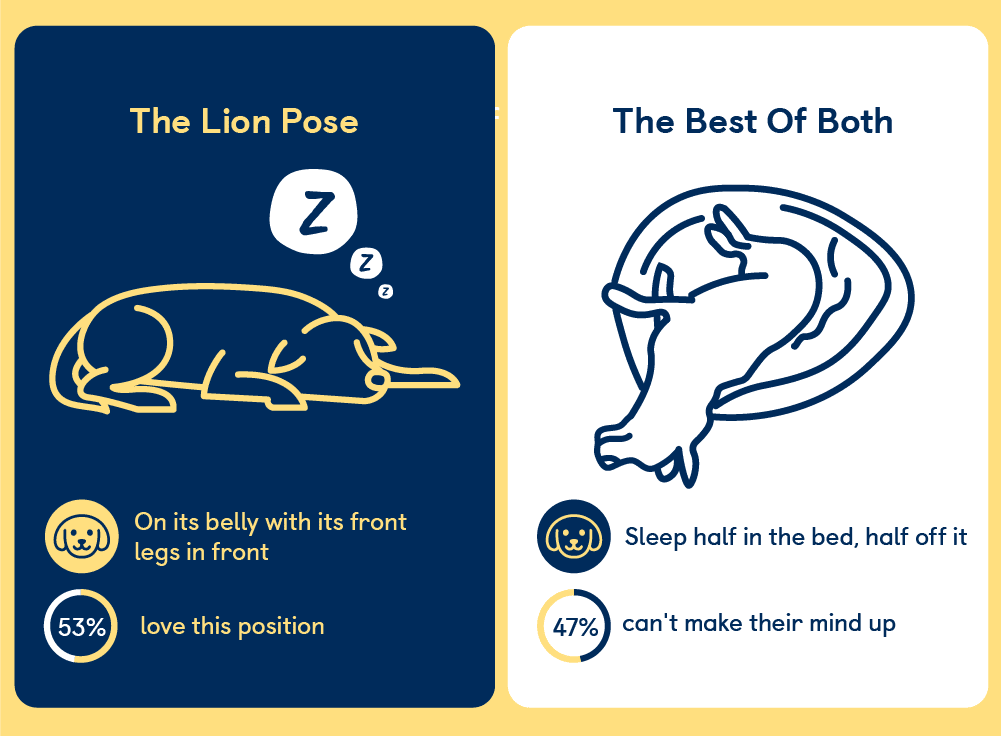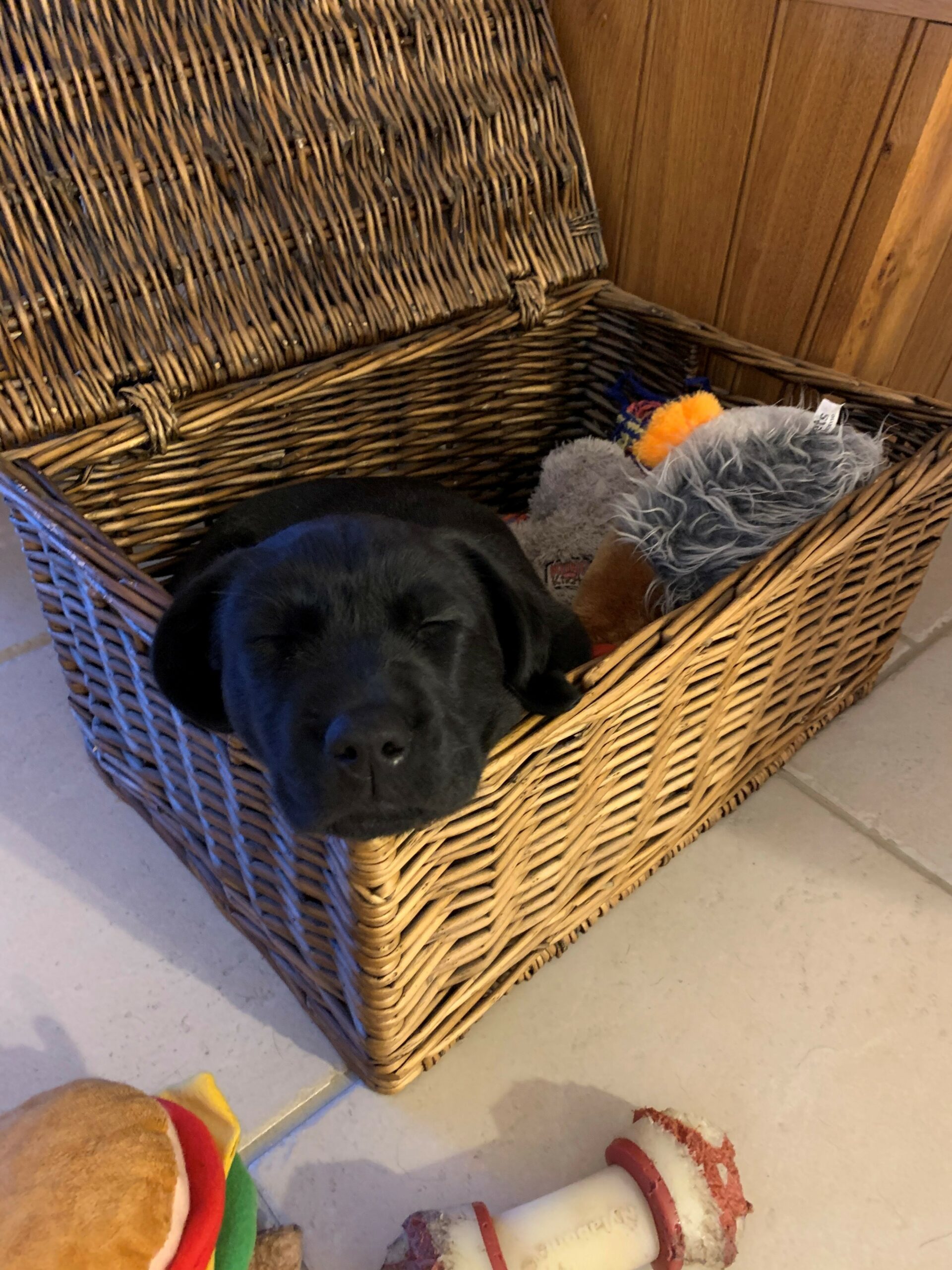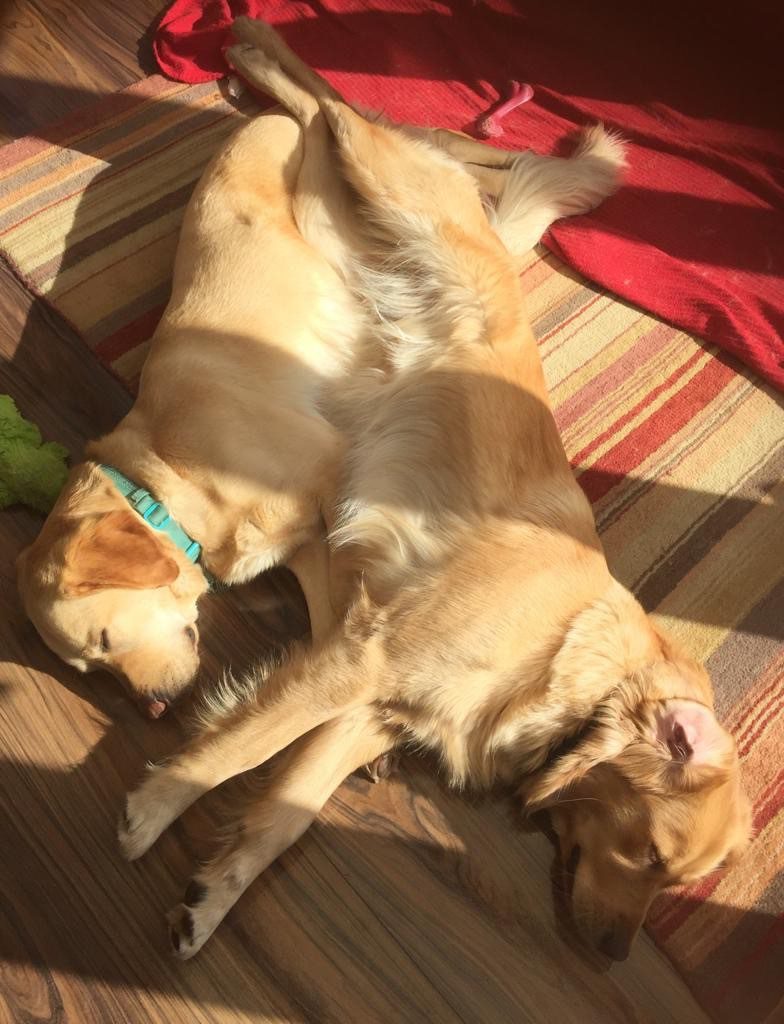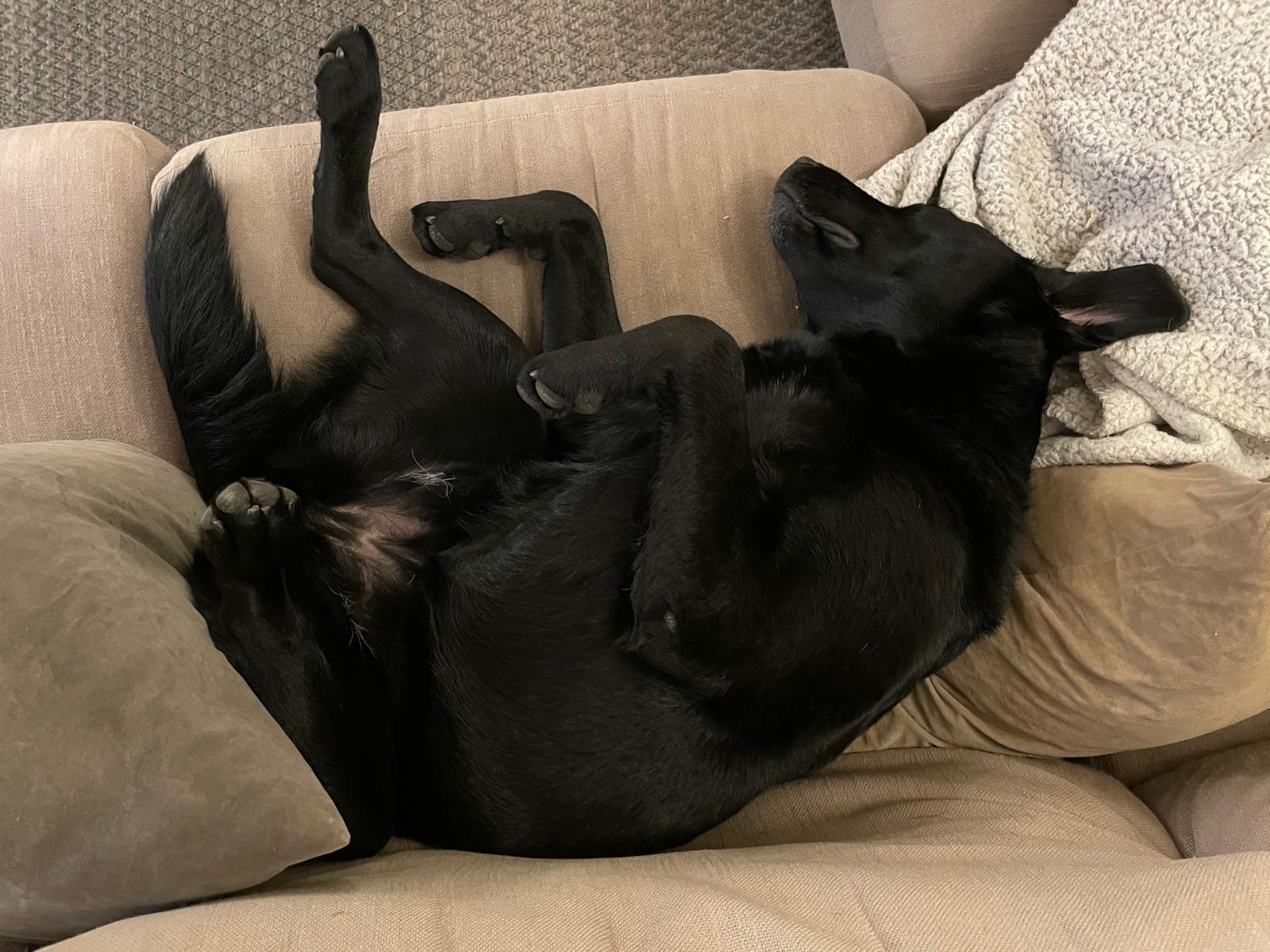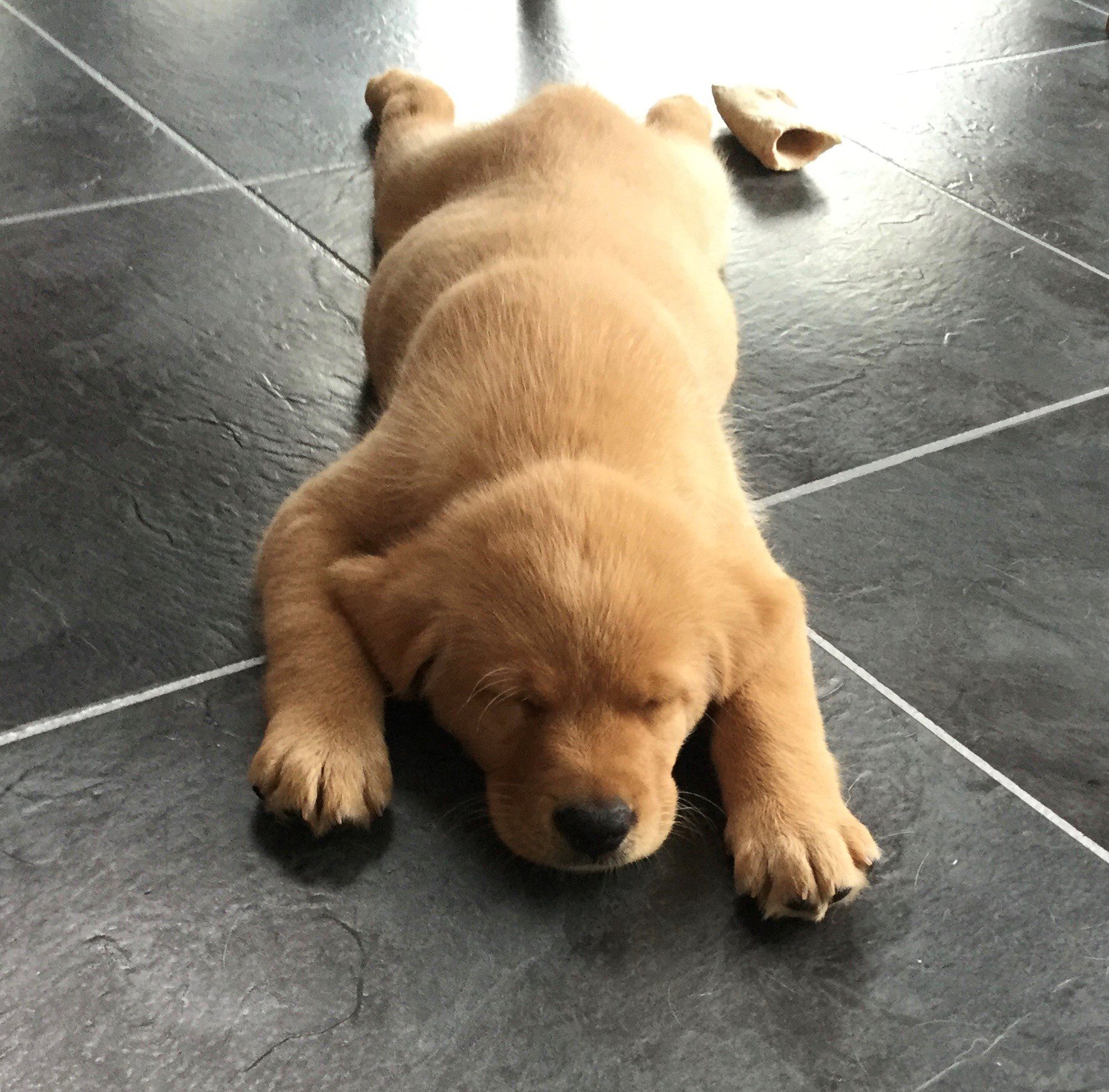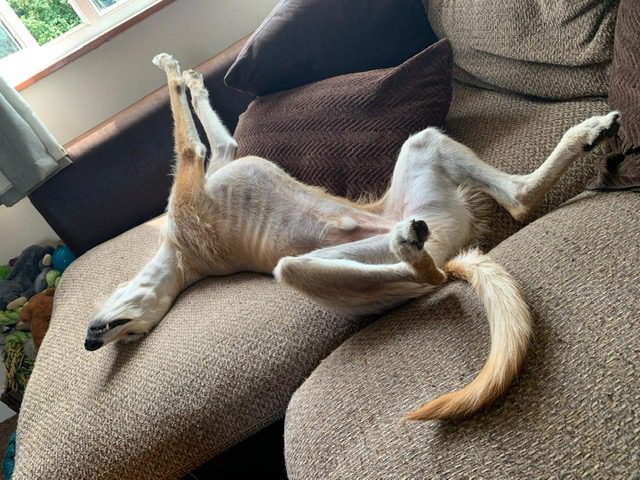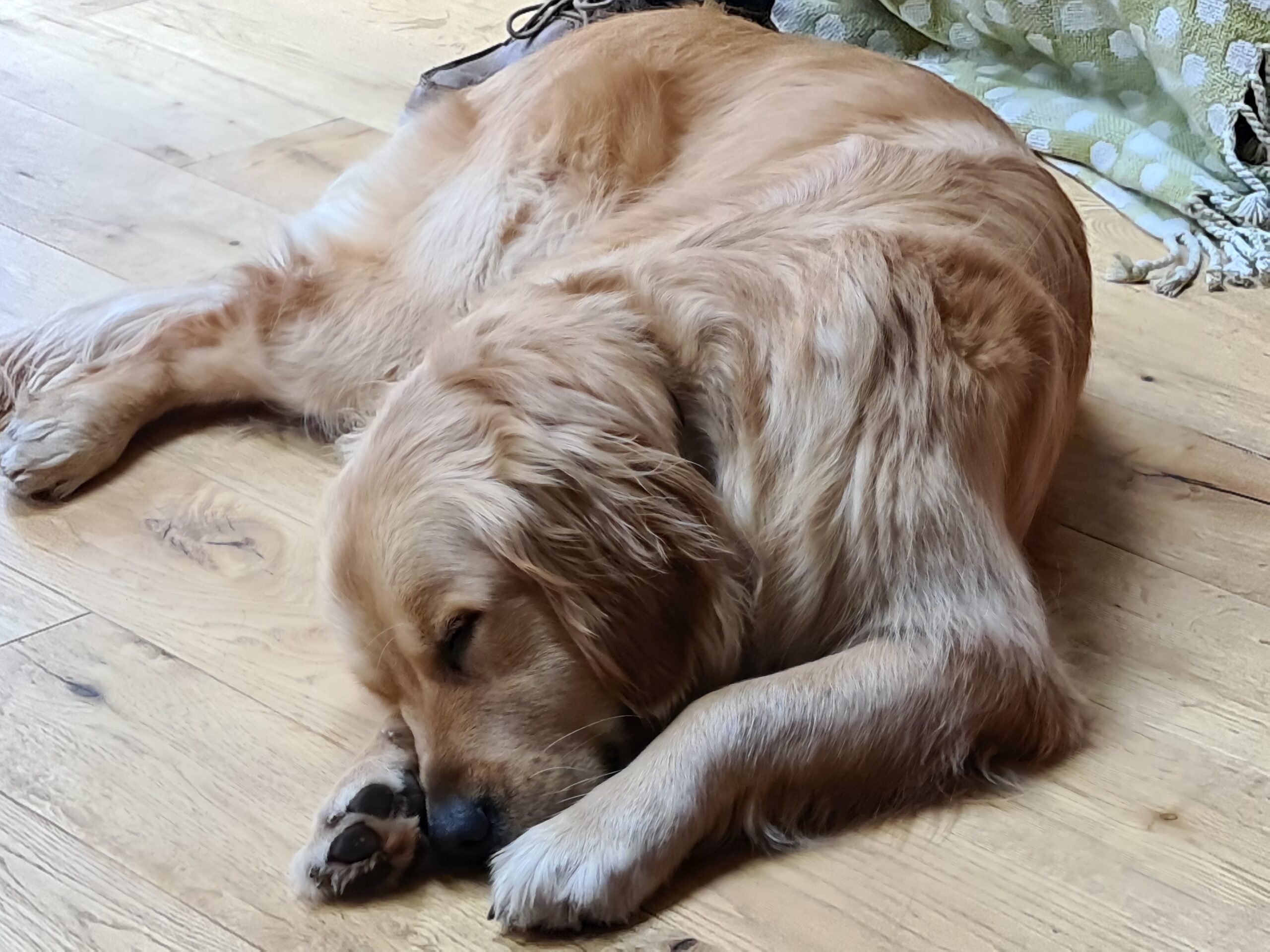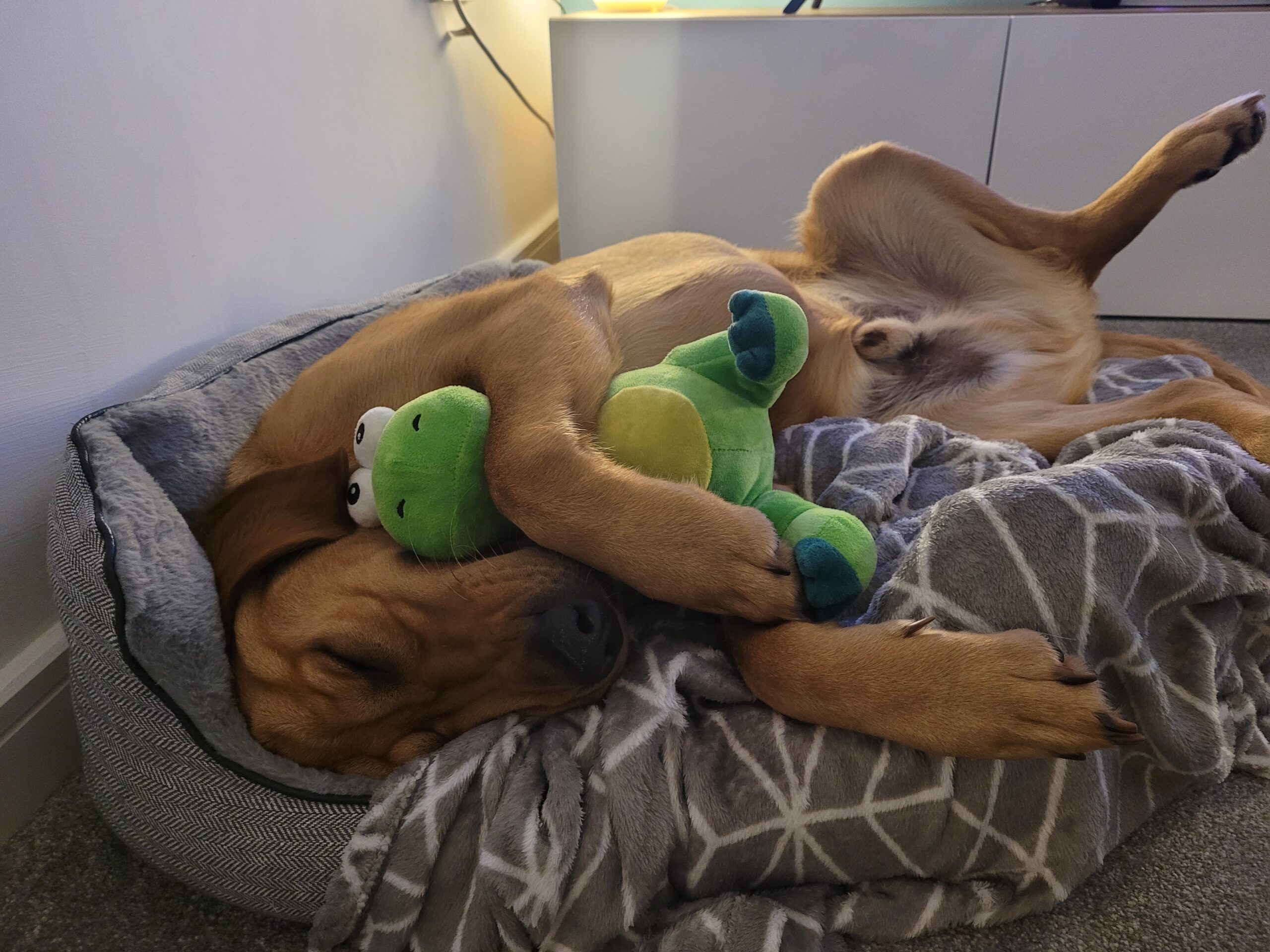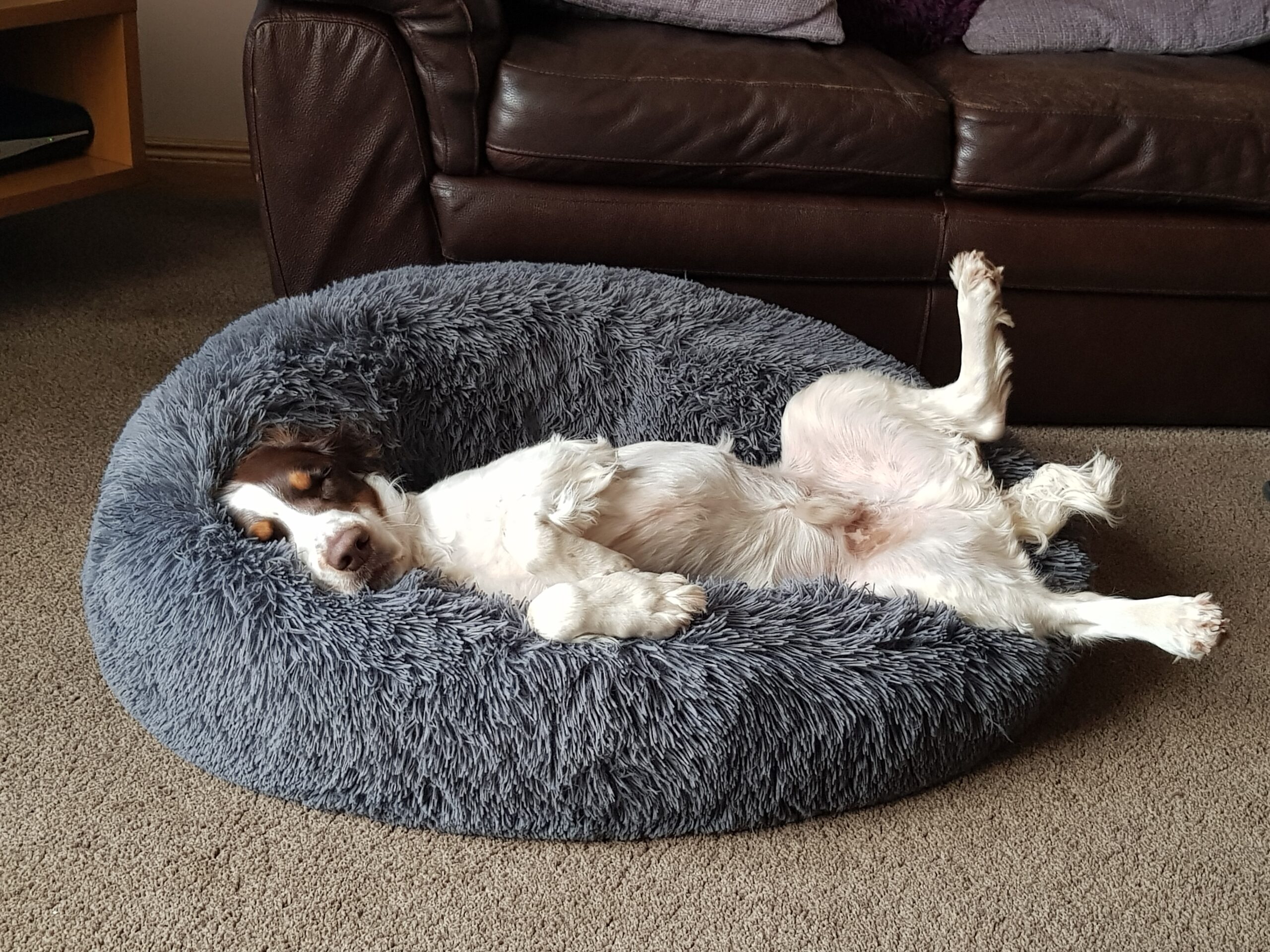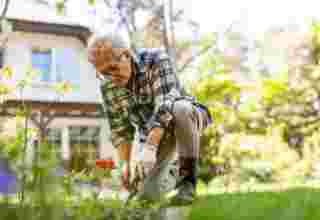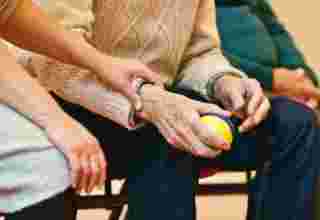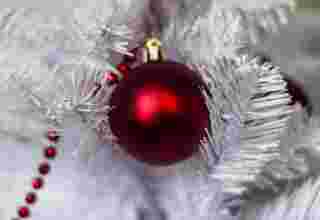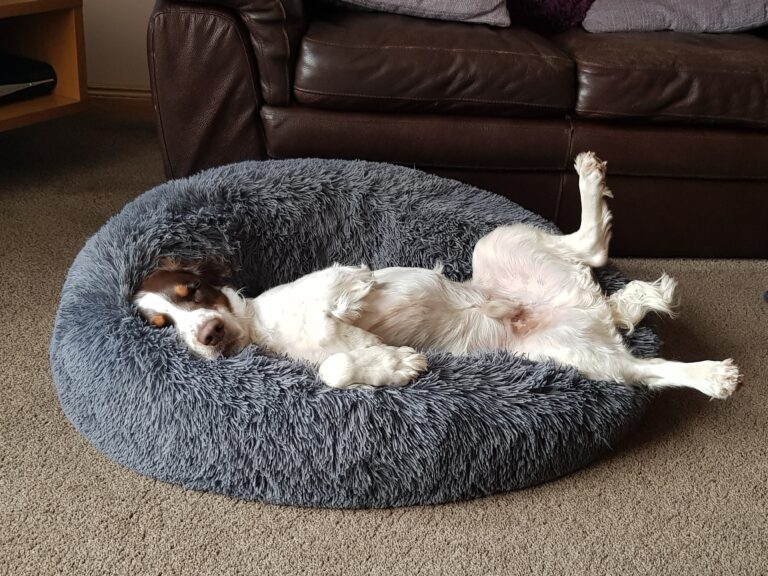
Guide Dogs is raising awareness of the importance of sleep in the development of the nation’s puppies – encouraging midday siestas and a calm and quiet environment to relax in.
To highlight this, they surveyed 2,000 dog owners to find out about the positions our canine companions adopt for some shuteye – and the cute and sometimes embarrassing antics that go with it.
Britain’s dog owners think their canine companions typically sleeps for around nine hours per day.
The most common position is for the dog to be curled up (71 per cent), while 57 per cent lay on their back with their legs in the air.
But it’s the strange locations where our dogs sleep which can raise an eyebrow.
While two thirds (67 per cent) choose the sensible route and sleep in their bed, one in 10 dogs has been found sleeping in a washing basket, while 24 per cent have chosen the arm of the armchair for a snooze.
Overall, 73 per cent of respondents admitted they were baffled by some of the sleeping positions they find their dogs in.
And while they’re odd in some of their behaviours, they’re like clockwork with others – as two thirds (66 per cent) say their dog wakes up at the same time each morning to see them.
Dr Helen Whiteside, Head of Research at Guide Dogs, said: “We’re a nation of dog lovers and our pets are part of our family. Sleep is incredibly important for a dog’s mental wellbeing, and it plays a significant role in learning and memory, which is why as part of our training at Guide Dogs we let our trainee guide dogs have a midday siesta.
“There are lots of things that owners can do to help their dog get some good quality shut eye.
“Dogs love routine so it’s important for your dog to have a calm quiet space with a comfortable temperature to sleep in. For puppies and younger dogs, getting the foundations right will help support the development of good long-term sleeping habits.”
When they do nod off, three quarters (75 per cent) of dogs appear to be in a deep sleep dream as they make strange noises and perform a static running action.
jQuery(document).ready(function($) {
// We only want these styles applied when javascript is enabled
$(‘.gal_content’).css(‘display’, ‘block’);
// Initialize Advanced Galleriffic Gallery
var gallery = $(‘#thumbs_62172_1’).galleriffic({
delay: 0,
numThumbs: 0,
preloadAhead: 0,
enableTopPager: false,
enableBottomPager: false,
imageContainerSel: ‘#slideshow_62172_1’,
controlsContainerSel: ‘#controls_62172_1’,
captionContainerSel: ‘#caption_62172_1’,
loadingContainerSel: ‘#loading_62172_1’,
renderSSControls: true,
renderNavControls: false,
playLinkText: ”,
pauseLinkText: ”,
enableHistory: false,
autoStart: false,
enableKeyboardNavigation: true,
syncTransitions: false,
defaultTransitionDuration: 300,
onTransitionOut: function(slide, caption, isSync, callback) {
slide.fadeTo(this.getDefaultTransitionDuration(isSync), 0.0, callback);
caption.fadeTo(this.getDefaultTransitionDuration(isSync), 0.0);
},
onTransitionIn: function(slide, caption, isSync) {
var duration = this.getDefaultTransitionDuration(isSync);
slide.fadeTo(duration, 1.0);
// Position the caption at the bottom of the image and set its opacity
var slideImage = slide.find(‘img’);
caption.fadeTo(duration, 1.0);
},
onPageTransitionOut: function(callback) {
//this.hide();
setTimeout(callback, 100); // wait a bit
},
onPageTransitionIn: function() {
var prevPageLink = this.find(‘a.prev’).css({‘opacity’: ‘0.3’ , ‘display’ : ‘inline-block’, ‘cursor’ : ‘default’});
var nextPageLink = this.find(‘a.next’).css({‘opacity’: ‘0.3’ , ‘display’ : ‘inline-block’, ‘cursor’ : ‘default’});
// Show appropriate next / prev page links
if (this.displayedPage > 0)
prevPageLink.css({‘opacity’ : ‘1’ , ‘display’ : ‘inline-block’, ‘cursor’ : ‘pointer’});
var lastPage = this.getNumPages() – 1;
if (this.displayedPage < lastPage)
nextPageLink.css({'opacity' : '1' , 'display' : 'inline-block', 'cursor' : 'pointer'});
this.fadeTo('fast', 1.0);
}
});
/**************** Event handlers for custom next / prev page links **********************/
gallery.find('a.prev').click(function(e) {
gallery.previousPage();
e.preventDefault();
});
gallery.find('a.next').click(function(e) {
gallery.nextPage();
e.preventDefault();
});
});
More than half (58 per cent) of dogs randomly let out a proper bark when they are sleeping.
And 41 per cent of dogs kick up a stink by waking themselves up by breaking wind in their sleep.
While the nation lovingly looks on or laughs as their furry friend sleeps, it’s important to remember the phrase ‘let sleeping dogs lie’.
This is after half of owners have startled their pet by waking them up, while 27 per cent have been growled or snapped at for trying to move them off their bed when they were asleep.
Three quarters (78 per cent) of respondents say it’s vital that children should be educated to know that they shouldn’t disturb a sleeping dog.
And you’ve got to feel for the 41 per cent of dogs who have been tripped over by their owners while they were sleeping.
The research carried out via OnePoll for Guide Dogs revealed a lack of education about dogs and their sleeping behaviour among Britain’s dog owners.
Just a third (33 per cent) have looked into how much sleep their puppy or dog should have. Of those who have, 70 per cent searched online, while 61 per cent consulted a vet and 54 per cent spoke to a friend.
Six in 10 (59 per cent) admitted they should educate themselves more on dogs and their sleeping patterns to ensure they’re living a healthy life.
A quarter said they had taken their dog to the vet because they were worried about its sleeping patterns.
jQuery(document).ready(function($) {
// We only want these styles applied when javascript is enabled
$(‘.gal_content’).css(‘display’, ‘block’);
// Initialize Advanced Galleriffic Gallery
var gallery = $(‘#thumbs_62172_2’).galleriffic({
delay: 0,
numThumbs: 0,
preloadAhead: 0,
enableTopPager: false,
enableBottomPager: false,
imageContainerSel: ‘#slideshow_62172_2’,
controlsContainerSel: ‘#controls_62172_2’,
captionContainerSel: ‘#caption_62172_2’,
loadingContainerSel: ‘#loading_62172_2’,
renderSSControls: true,
renderNavControls: false,
playLinkText: ”,
pauseLinkText: ”,
enableHistory: false,
autoStart: false,
enableKeyboardNavigation: true,
syncTransitions: false,
defaultTransitionDuration: 300,
onTransitionOut: function(slide, caption, isSync, callback) {
slide.fadeTo(this.getDefaultTransitionDuration(isSync), 0.0, callback);
caption.fadeTo(this.getDefaultTransitionDuration(isSync), 0.0);
},
onTransitionIn: function(slide, caption, isSync) {
var duration = this.getDefaultTransitionDuration(isSync);
slide.fadeTo(duration, 1.0);
// Position the caption at the bottom of the image and set its opacity
var slideImage = slide.find(‘img’);
caption.fadeTo(duration, 1.0);
},
onPageTransitionOut: function(callback) {
//this.hide();
setTimeout(callback, 100); // wait a bit
},
onPageTransitionIn: function() {
var prevPageLink = this.find(‘a.prev’).css({‘opacity’: ‘0.3’ , ‘display’ : ‘inline-block’, ‘cursor’ : ‘default’});
var nextPageLink = this.find(‘a.next’).css({‘opacity’: ‘0.3’ , ‘display’ : ‘inline-block’, ‘cursor’ : ‘default’});
// Show appropriate next / prev page links
if (this.displayedPage > 0)
prevPageLink.css({‘opacity’ : ‘1’ , ‘display’ : ‘inline-block’, ‘cursor’ : ‘pointer’});
var lastPage = this.getNumPages() – 1;
if (this.displayedPage < lastPage)
nextPageLink.css({'opacity' : '1' , 'display' : 'inline-block', 'cursor' : 'pointer'});
this.fadeTo('fast', 1.0);
}
});
/**************** Event handlers for custom next / prev page links **********************/
gallery.find('a.prev').click(function(e) {
gallery.previousPage();
e.preventDefault();
});
gallery.find('a.next').click(function(e) {
gallery.nextPage();
e.preventDefault();
});
});
Tim Stafford, Director of Canine Affairs at Guide Dogs, said: “We all love our dogs, but more than half of people admit they should educate themselves more on dogs and their sleeping patterns to ensure they’re living a healthy life.
“To help our dogs get the best possible sleep it’s important to give them a choice, not only in where they sleep but the type of bed they chose to sleep in – some dogs will prefer certain types of beds, while others will opt for no bed at all.
“It’s also really important to recognise that when a dog is in a bed it should be like a ‘do not disturb’ sign as, just like some people, some dogs can be grumpy if they are suddenly woken up from a deep sleep.”
Alongside the infographic of the Dogs of the UK’s sleeping behaviour, Guide Dogs has also assembled an adorable collection of photographs showing the nation’s dogs asleep.
Guide Dogs has expert advice [guidedogs.org.uk/good-dog/] for making life with your dog a walk in the park.



